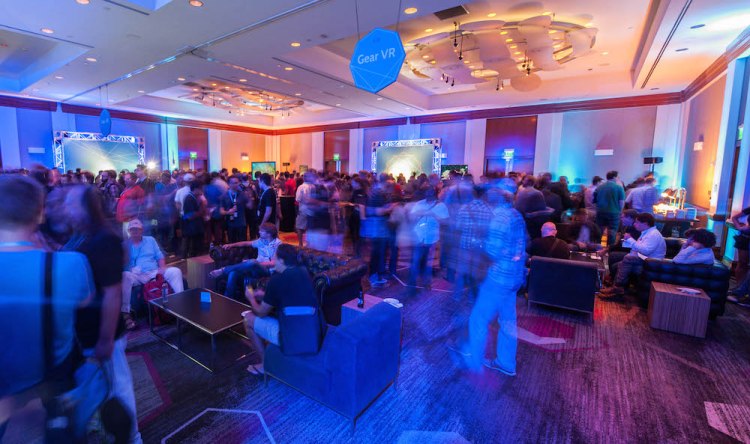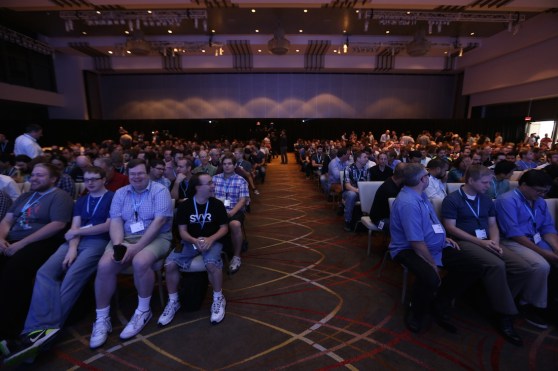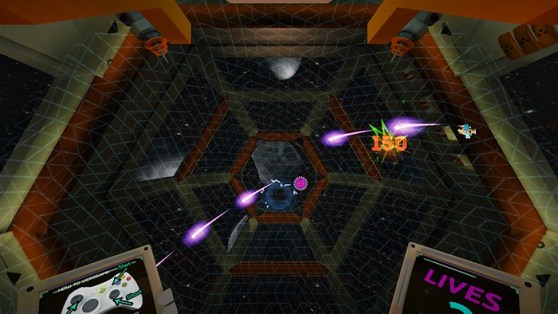One of the busiest rooms at Oculus Connect was the developer lounge. It offered extra space, chairs, and, most importantly, electrical outlets for those who couldn’t find any outside. When I wasn’t conducting interviews or watching a panel, I came here to see what kind of things people were working on. The crowd of developers changed throughout the day, so I usually found something new to try whenever I dropped in.
It’s here where I reconnected with Andrew Goldstein, executive producer of Otherworld Interactive. I first met him on Friday afternoon, just an hour before the conference began. At the time, Otherworld had already set up laptops and Rift headsets for its demos. More than 24 hours later, I wanted to ask Goldstein what his experience had been like now that Connect was drawing to a close.
“I think [the atmosphere here] is really experimental, which is cool because everyone who’s into VR is into it for different reasons and want to do different things with it,” said Goldstein. “So a lot of people are trying lots of stuff, which I think is really cool because VR, like [when film began], doesn’t have a language yet. There’s nothing to tell you what to do and what not to do. It’s almost like the beginning of film … and right now, developers and people are building the language of virtual reality, which is so cool because you can look at a game and say, ‘What did they do really well? What kind of things did they contribute?’”
Otherworld’s team — Goldstein, lead designer Robyn Gray, and creative director Michael Murdock — are all recent graduates from the University of Southern California’s MFA program for interactive media and games. For Oculus Connect, they showed several different projects, including an arcade shooter and a spooky demo that trapped you in a room with a haunted doll. Together, the three developers take on contract work to help keep the company afloat. They don’t have to rely on making games just for the consumer version of the Rift.
“We’re starting to get other companies really interested in doing virtual reality work,” said Goldstein. “And that’s enough for some of the devs to thrive on and to start to build other things for clients and for companies that are really interested in it. … Thankfully, [working in VR] is not that scary yet because there are other ways to keep the lights on.”
‘We’re all in this together.’
OlivierJT said something in our interview that, in retrospect, is a good summation of Oculus Connect: Everybody in the VR community is accessible. Oculus VR quickly transitioned from a plucky start-up to a billion-dollar company, but that doesn’t seem to have changed the way it interacts with its development community. During a panel about the construction of the first Rift development kit, Luckey sat in the audience with everyone else while his coworker, Oculus engineer Nirav Patel, talked on stage. A small crowd later formed around Luckey when the presentation was over.
Another Oculus executive that drew people and feverish chatter was chief technical officer (and the legendary programmer behind games like Doom and Quake) John Carmack. While standing in line for a demo, a guy behind me was freaking out because Carmack was only a few feet away from us. He really wanted to take a picture with him.
I asked Luckey if it feels weird to have so many people look up to you like that.
“Not really. We’re all trying to do the same thing,” said Luckey. “I’m on the hardware side and working at Oculus, but we’re all kind of the same in a lot of ways. It’s not like hero-worship or anything as much as it’s just like we’re all in this together. I’m no [Valve CEO] Gabe Newell or something.”
I told him he’s well on his way to reaching that level of fame.
“We’ll see. … I’m getting out there, too. It’ll be worth the weight,” he joked.
VentureBeat's mission is to be a digital town square for technical decision-makers to gain knowledge about transformative enterprise technology and transact. Learn More



